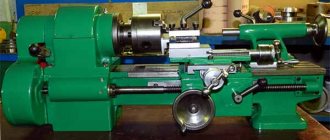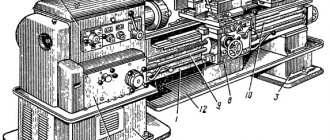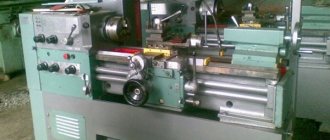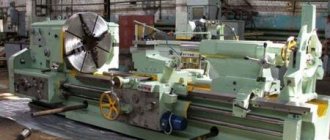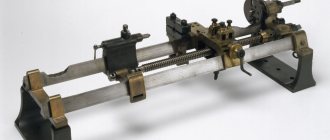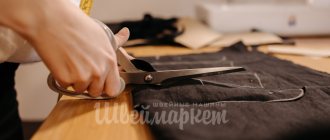The history of the creation of the first machine in the world
The history of the appearance and development of the lathe dates back to 650 BC. e. This is documented by an engraving found by archaeologists. It depicts people in tunics watching master Fyodor work on a foot-operated lathe. The part was fixed between 2 centers and driven by a lever.
The workpiece in such a machine rotated alternately several revolutions towards the tool, then back, away from it. The cutter was held in the hands. The cutting force was weak and the accuracy was low. On such a machine they could process:
- tree;
- horn;
- bone;
- non-ferrous metals;
- bronze
Historians have found jewelry made using similar equipment.
Reference! A lot of time was spent on making the simplest product; half of it was spent on reverse rotation. But compared to manual processing, the technology was highly productive and distinguished by high precision in creating a round surface.
First mentions
The first images of lathes were found in ancient Egypt. The beam drive mechanism is clearly visible on the frescoes. The string was wrapped around a part clamped in the center at one end and pulled onto the bow. The slave moved the device back and forth, rotating the wooden piece in one direction or the other. The master sits on the floor and guides the tool.
Over time, a longitudinal ruler appeared on Egyptian bow lathes. It had divisions and the cutter rested on it when working. Now it was possible to create relatively identical parts, for example, table legs and columns.
Over time, foot-operated lathes appeared. They worked like archers, but they could do without a slave. The elastic force of a living tree branch was used. One end of the rope wrapped around the part hung in a loop below, the other was tied to a branch on the tree. The master inserted his foot into the loop and pressed down. The part made several turns in one direction. Then he released the rope, the branch straightened and rotated the structure in the opposite direction.
In the drawing from 1400, a wooden machine is installed indoors and has movable heads for working with workpieces of different lengths. In 1518, the machine tool of Emperor Maximilian was made. It had metal centers and a movable rest that moved along guides. All body parts were covered with patterns imitating ancient towers and castles. The handles are made in the shape of warriors.
Reference! The first machines with continuous rotation in one direction are described in the Book of Solomon in 1615. The helper rotated the handle of a large wheel connected by a belt drive to a pulley on the machine. On such machines, not only the surface was processed, but also the ends of the part, and boring was done.
Scientists inventors, who invented?
Drawings of lathes and individual components developed by Leonardo da Vinci have survived to this day. But not a single unit was built according to them. Around 1570, Charles IV, as king of France, commissioned Jacques Besson to create a lathe for cutting threads. He installed a third headstock, which held the cutter and retracted it during reverse rotation.
Scientists and inventors of the lathe include:
- Andrey Konstantinovich Nartov, mechanic of Peter the Great, mechanized thread cutting.
- Alexey Suponini and Pavel Zakhava, Tula mechanics, improved the design of the caliper.
- The Frenchman J. Vaucanson created the prototype of a universal machine on a powerful frame with metal components.
- The Englishman D Ramedon designed 2 types of thread cutting machines.
- The French mechanic Senault created equipment for cutting screws.
- Mondsley built a universal lathe, which eventually became the basic model.
- D Clement installed the lead screw at the front of the bed and pulled it through the apron.
- D Vivort is the author of automatic cross feed.
- American Fitch designed and built a turret machine.
- K Vipil and T Sloan created automatic woodworking machines.
- HR Spencer built the first universal machine gun.
Henry Mondsley improved the caliper, automated thread cutting, and was the first to raise the issue of unifying some parts. He developed the main standard sizes and standardized the threads.
The Americans picked up Mondsley's idea, and soon began to produce standardized parts. This allowed them to launch conveyors, significantly increase labor productivity, reducing most of the workers.
Important!
Before the discovery of Nartov, a strip of paper equal in width to the pitch was wound onto the shaft for cutting threads. Then, with a sharp tool, a helix line was marked in the gap between the strips. After this, the threads were turned by hand using files.
The device of the first models
The first models that can be confidently called lathes were designs with a cable-hand drive and a machine described in 1671 by Cheruben. It had a foot drive and a crankshaft, thanks to which the rotation was in one direction. The step-pulley drive made it possible to change the rotation speed of the part.
With the advent of the water wheel, machines were switched to mechanical drive. A long shaft with a large number of pulleys stretched across the workshop. Each machine was connected to the drive shaft by a belt drive.
Control
After the introduction of Nartov's invention in 1712 - a self-propelled caliper, the problem of attaching and moving the tool was solved. Now the rotation of the part was turned on and the belt was thrown onto a pulley of the required diameter.
The longitudinal movement of the caliper was carried out from a screw connected to the drive. The feed pitch was controlled by a copying finger. He adjusted the pitch and feed ratio of the caliper. Then came the invention of Vaucanson and the caliper received a mechanical transverse transmission and at the same time could be controlled manually.
Since 1800, lathes have all modern components and control units. Torque is transmitted from the drive through a belt drive. The rigid dependence of longitudinal and transverse feeds on rotation speed is ensured by gearing. Handles for switching to different cutting modes appeared on the support.
Metal parts
The first metal parts on a lathe appeared on the model of Emperor Maximilian in 1518. These were rotating centers in which the workpiece was clamped. Nartov created a thread cutting machine in 1712. In it, torque was transmitted through gears and a screw shaft. All parts were iron.
The first all-metal lathe was made by Vaucanson in 1751. The French mechanic treated his invention as a tool and removed all decorative decorations, leaving only functional components and parts. His machine looked simple, had a massive cast-iron frame and could withstand heavy loads when processing metal.
Starting from this time, guides for the caliper and tailstock appeared on the frames. Machine tools began to be made from steel and cast iron parts. The models had all the components of modern turning equipment.
Position sensors
The first position sensors were copying fingers. They slid along the screw and set longitudinal and transverse movement. The ability to move the tailstock made it possible to install parts of different lengths and even machine wide workpieces from the end.
When the movement of the caliper and tailstock began to occur along the guides, rulers with divisions appeared that determined the position of the cutter. The production of precise carvings gave rise to the creation of limbs. Now it was possible to confidently say how much the caliper and tool holder would move per full revolution, and at what angle the knob should be turned to move by 1 mm.
Drive mechanisms
The lathe drive has gone through several stages of evolution:
- manual and foot with return rotation;
- manual rotation in one direction;
- movement from a water wheel;
- steam drive;
- electric motor
From 1837 to 1842, Robert Davidson designed electric drives, including for lathes. The asynchronous three-phase motor was invented by Dolivo-Dobrovolsky in 1891. But only after the 1917 revolution they began to install it on lathes and other equipment.
Dimensions and weight
The first machines processed parts with a diameter of up to 200 mm and a length of up to 1200 mm. The weight of the wooden equipment was 50–100 kg. The simplest tabletop lathes weigh 70–120 kg when assembled. They process metal workpieces weighing 12–35 kg. Industrial turning equipment weighs from 1.2 tons. Metal parts with a diameter of 200 mm and a length of 800–3000 mm are installed on it.
Biography
The famous engineer was born in London on August 22, 1771. His father was a former military man. At the time of his son's birth, he was working at the Royal Arsenal. Like many children of those times, Henry began working at the age of 12. His job was to put gunpowder into artillery cartridges. Subsequently, he moved to a carpentry workshop, and by the age of 15 he began to learn the profession of a blacksmith.
In 1789, Maudsley managed to get into the mechanical workshop of Joseph Bramah. And already in 1794, the future scientist designed a cross support for a lathe. It made it possible to turn bolts and screws automatically, and this could be done with any thread. In 1797, the master managed to make a screw-cutting lathe. It had a caliper and a set of gears.
In 1800, the scientist managed to design the first metal-cutting machine that could be used in industry. It made it possible to standardize thread sizes. This development made it possible to use the principle of interchangeability. Thanks to this, it was possible to use bolts and nuts in practice.
Until this point, carvings were usually carved by experienced workers using a rather primitive technique. They marked a groove on the workpiece, and then cut it with a file, chisel and other devices. As a result, the nuts and bolts had non-standard sizes. Therefore, the nut corresponded only to a specific bolt.
Nuts were used extremely rarely in those days, and metal screws were used mainly for woodworking. At the same time, Maudsley managed to standardize the production of threads. In addition, the scientist produced sets of dies and taps. This made the bolt fit any nut of the right size. This was an important step in the manufacture of equipment and in scientific progress in general.
Already in 1810, Henry Maudsley managed to open an engineering plant. At the same time, in 1815 he created a machine line for the production of rope blocks for ships.
In addition, the scientist was the first to create a micrometer that ensured high accuracy of measurements. The researcher called his invention “Lord Chancellor”. It was used to resolve any issues regarding the accuracy of part measurements.
The researcher also came up with a machine for making holes in boiler iron. In addition, the inventor created a tunneling shield, with the help of which it was possible to build a tunnel under the Thames.
In old age, the scientist became interested in astronomy. This prompted him to begin building a telescope. The researcher was going to buy a house in one of the London districts and create a private observatory there. However, illness and then death ruined his plans.
In January 1831, the scientist was returning from France from his friend. While traveling across the English Channel, he caught a cold. After 4 weeks of illness, the scientist died. This happened in February 1831. The famous inventor was buried in Woolwich, south London.
What features did early models have?
Early models had a common drive for all. Rotation was transmitted through belt drives. The number of revolutions of the workpiece could not be set accurately. The longitudinal and transverse movement of the caliper depended on the number of shaft revolutions and was regulated by rearranging the gears in the feed box. The spindle rotation speed was set by throwing the belt onto a pulley of the required diameter.
The accuracy of the transverse and longitudinal feed of the tool was 0.1 mm - the error of manual movement along the dial. It was not possible to automate the machining process on early models and produce large batches of parts with high accuracy of fit.
The lathe has a long history. It reflects the technical level of development of peoples, their desire to simplify the manufacture of parts and create beautiful things of the correct shape.
What did Henry Maudsley invent?
Each creation of a scientist became an important stage in the industrial revolution. His inventions served as the basis for the subsequent development of science.
Screw-cutting lathe
For a long time, when processing metal workpieces, turners were forced to hold the cutter in their hands. This type of work was very uncomfortable and dangerous. In addition, achieving equal accuracy of products was very difficult. Then Maudsley decided to add a special support to the lathe. He helped fix the cutting tool. This happened in 1797.
Thanks to Maudsley's invention, it was possible to achieve rigid installation of the cutter in two planes. This made the work more accurate. The scientist’s machine helped to produce nuts and bolts with a clear thread pitch.
Powered lathe support
The first improvement to the Maudsley machine was the use of a powered slide. Using a gear drive, the scientist connected the lead screw and the spindle. By rotating it, it was possible to move the cutter along the machine body, positioning it with a high degree of accuracy. At the same time, the researcher made a new set of lead screws for the machine. Changing them made it possible to obtain threads of different sizes.
Original set of replacement gears
A couple of years later, the scientist again improved his invention. Instead of lead screws, the researcher decided to use a set of wheels that had different numbers of teeth. With their help, rotation was transmitted. Such products were easier to manufacture and operate.
The use of different combinations helped to obtain different thread profiles with one lead screw. It also allowed for slicing left and right. The precision of the machine was so high that it was possible to see the threads on individual screws only using a magnifying glass.
Cross-planing machine with crank mechanism
In the first half of the nineteenth century, Maudsley, who was not very rich, was lucky. He managed to get a contract to create a real industrial line for the production of ship blocks.
The scientist led the development for the Royal Navy together with French engineer Marc Brunel. A total of 43 machines were designed, one of which was a new cross-planing design. It made it possible to accurately process workpieces made from elm and backwood, the hardest types of wood used in the shipbuilding industry.
Henry Maudsley managed to make an important contribution to the development of mechanical engineering at the initial stage of its inception. His main achievement was the creation of machines that were used for many years in workshops around the world and served as the basis for further inventions in this area.
